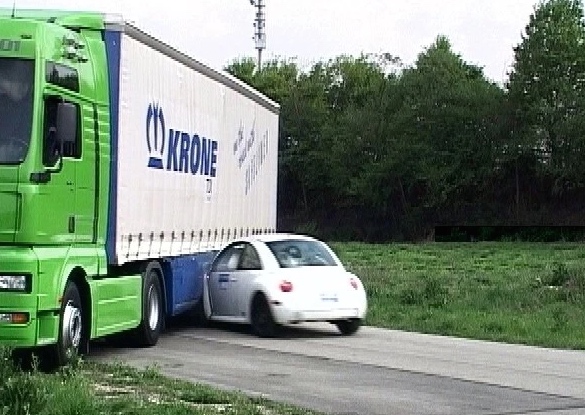This Simple Truck Design Might Have Prevented The Fatal Tesla Model S Crash
About two months ago, a driver of a Tesla Model S was tragically killed when he crashed into the side of a tractor-trailer. In the process, the top half of the Model S was sheared off as the car — which was reportedly traveling in excess of 80 MPH — went underneath the trailer before crashing into a power pole. At the time, the driver of the Model S had the car's Autopilot software activated.
As is to be expected, the crash has kickstarted a firestorm of debate regarding self-driving car technology. Another topic (via Treehugger) that hasn't been addressed quite as much, but is no less important, is whether or not we should outfit tractor trailers with more safety measures. The reason to do so is obvious: according to one report from the National Highway Traffic Safety Administration (NHTSA), an estimated 15% of "large truck fatalities involved passenger cars striking the sides of either the tractor or trailer."
DON'T MISS: Foxconn spy shot reveals new iPhone 7 details no one saw coming
And addressing instances in which a car goes underneath a trailer, the NHTSA adds: "Side underride collisions are an important safety problem because they defeat crumple zones and prevent air bag deployment, both vital safety advances in improving protection of passenger vehicle occupants during crashes."
What's more, crash data reveals that when a car collides with a truck from a perpendicular position, it dangerously goes underneath the trailer 69% of the time.
That being the case, would the aforementioned Tesla Model S crash have been a non-fatal incident had the tractor trailer involved featured a side guard as illustrated in the photos above and below?

As to the crash specifically involving the Tesla Model S, one hesitates to say that such a design would have saved the driver's life given how fast he was reportedly going. Nonetheless, such a design could undoubtedly help in instances involving lower-impact collisions.
Note the following from Tesla's official statement on the crash:
The high ride height of the trailer combined with its positioning across the road and the extremely rare circumstances of the impact caused the Model S to pass under the trailer, with the bottom of the trailer impacting the windshield of the Model S. Had the Model S impacted the front or rear of the trailer, even at high speed, its advanced crash safety system would likely have prevented serious injury as it has in numerous other similar incidents.
As the photo below demonstrates, a truck outfitted with a side guard can be the difference between a crash and a deadly crash.

Additionally, it's worth noting that the Tesla's Autopilot software might have been able to identify the truck as an obstacle and applied the brakes if it was outfitted with side guards. Recall, Tesla has since come out and said that the Autopilot software likely mistook the truck for an overhead highway sign.
To this point, Elon Musk tweeted out the following a few days ago in reference to the crash.
Radar tunes out what looks like an overhead road sign to avoid false braking events
— Elon Musk (@elonmusk) June 30, 2016
Interestingly enough, Treehugger points out that truck designs such as those seen above are standard across Europe. In the United States, the city of Boston made such side guards mandatory back in 2014.
But if other U.S. cities and manufacturers refuse to adopt similar common-sense safety measures, it stands to reason that we're unnecessarily putting drivers at risk. Hopefully, a debate over self-driving cars isn't the only issue that the tragic Tesla Model S crash brings to the forefront.
And lastly, the following video shows what a difference side guards and metal barriers can make in the event of a crash.
